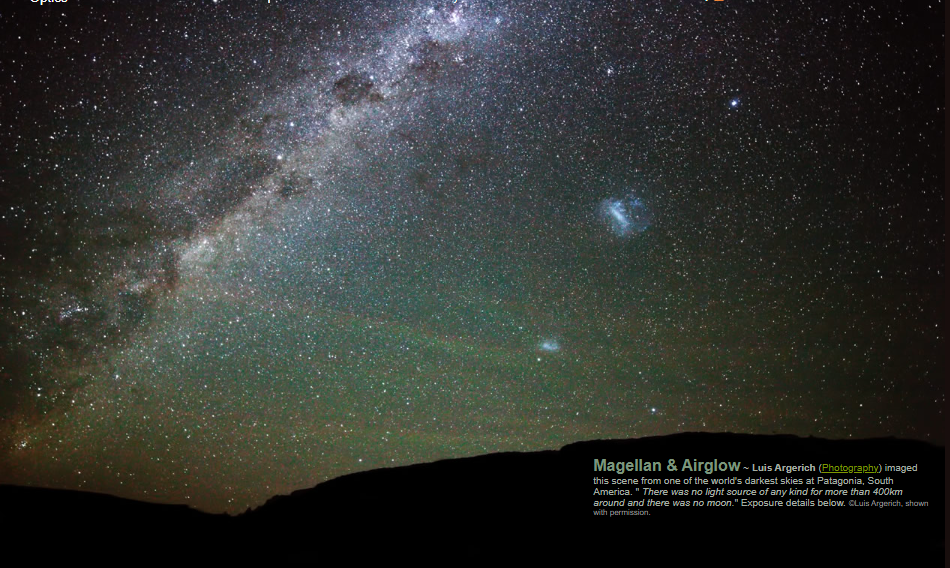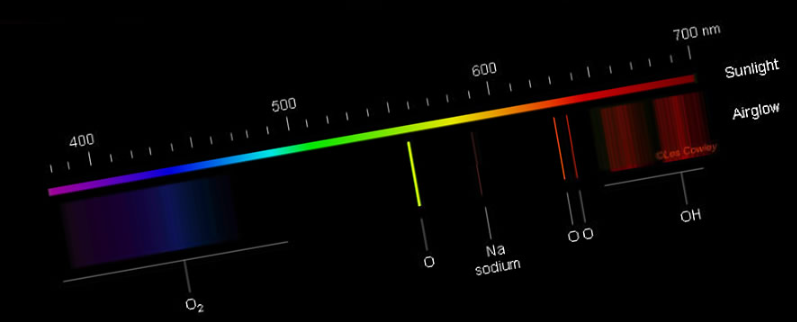OPOD - Magellan & Airglow
OPOD - Magellan & Airglow: Illuminating the Night Sky
Have you ever gazed up at the night sky and marveled at the beauty of the Milky Way? In the vast expanse of darkness, it is accompanied by the ethereal glow of the Magellanic Clouds, two dwarf galaxies. However, there is another source of light that suffuses the atmosphere above us - airglow. This captivating phenomenon adds an enchanting touch to the celestial canvas, and in this article, we will delve into the intricacies of Magellan & Airglow, shedding light on its origins and mesmerizing characteristics.
The Origins of Airglow
The mesmerizing green and red banded glow of airglow is a result of atoms and molecules in our upper atmosphere becoming excited by daytime far ultraviolet radiation. These excited particles subsequently emit light as they return to their lower energy states. The green glow originates from excited oxygen atoms radiating to a lower excited state at an altitude of 90 - 100km (56 - 62 miles). On the other hand, the source of the red glow is believed to be OH radicals, which also emit light within a narrow altitude range.
The Competition of Decay and Collisions
The narrow altitude range of the airglow's green and red bands is a fascinating outcome of the interplay between radiative decay and de-excitation through collisions. The slow radiative decay process, taking approximately one second, competes with collisions that can cause de-excitation. Additionally, the concentration of atomic oxygen varies with height, further influencing the altitude range of the airglow. These complex dynamics create the distinct banded glow that captivates stargazers.
Perturbations from Gravity Waves
The upper atmosphere, where airglow manifests, is not a tranquil place. It is perturbed by gravity waves that originate from disturbances at lower levels. These waves modulate the density and temperature of the atmosphere, ultimately impacting the balance of the airglow processes. The result is the formation of the mesmerizing banded glow that adds another layer of wonder to our nighttime skies.
The Quest to Witness Airglow
Observing airglow is no easy feat. It demands patience, a long period of dark adaptation, and a moonless sky devoid of light pollution. Only under such conditions can one fully appreciate the ethereal beauty of this atmospheric phenomenon. Photographers like Luis Argerich, who captured the stunning image showcased in this article, often seek out the darkest skies, far from any source of light pollution, to reveal the true splendor of airglow.
Capturing the Magic: Exposure Details
Luis Argerich's awe-inspiring photograph was taken from one of the world's darkest skies in Patagonia, South America. With no light source within a radius of over 400 kilometers (248 miles) and no moon in sight, the conditions were ideal for capturing the enchanting airglow. Argerich used a Canon EOS 5D camera with a 14mm lens set at f/2.8. The exposure was set at 30 seconds, allowing the camera to capture the delicate nuances of the airglow. With an ISO setting of 3200, the image beautifully showcases the vibrant colors and intricate details of this celestial phenomenon.
Conclusion
Magellan & Airglow offers us a glimpse into the captivating world of atmospheric optics. As we gaze at the night sky, we are not only witness to the distant stars and galaxies but also to the ethereal glow emanating from our own upper atmosphere. The interplay between excited particles, radiative decay, collisions, and gravity waves gives rise to the mesmerizing banded glow that adds a touch of magic to our nocturnal experiences. So, next time you find yourself under a moonless sky, take a moment to appreciate the wonders of airglow and let it transport you to the realm of celestial enchantment.

Magellan & Airglow ~ Luis Argerich (Photography) imaged this scene from one of the world's darkest skies at Patagonia, South America. " There was no light source of any kind for more than 400km around and there was no moon." Exposure details below. ©Luis Argerich, shown with permission.

The Milky Way spans the sky accompanied by the dwarf galaxies of the Magellanic Clouds. Suffusing all is a much closer light, ‘airlight’ from our own upper atmosphere.
The green and red banded glow is produced by atoms and molecules whose exitation derives ultimately from daytime far ultra violet radiation.
The green light is from excited oxygen atoms radiating to a lower excited state (O 1S to 1D) at an altitude of 90 – 100km (56 - 62 miles).
The narrow altitude range is the result of competition between the slow radiative decay (~1s) and de-excitation by collisions coupled with the variation of atomic oxygen concentration with height. The red glow is possibly from OH radicals. They also emit in a narrow altitude range.
The upper atmosphere is perturbed by gravity waves emanating from disturbances at lower levels. The waves modulate the atmospheric density and temperature with subsequent effects on the balance of the airglow processes that then result in a banded glow.
To see airglow demands a long dark adaption and a moonless sky free of light pollution.
Luis Argerich's exposure was 30s at ISO 3200, 14mm lens at f/2.8 Canon EOS 5D.
Note: this article has been automatically converted from the old site and may not appear as intended. You can find the original article here.
Reference Atmospheric Optics
If you use any of the definitions, information, or data presented on Atmospheric Optics, please copy the link or reference below to properly credit us as the reference source. Thank you!
-
<a href="https://atoptics.co.uk/blog/opod-magellan-airglow/">OPOD - Magellan & Airglow</a>
-
"OPOD - Magellan & Airglow". Atmospheric Optics. Accessed on November 26, 2024. https://atoptics.co.uk/blog/opod-magellan-airglow/.
-
"OPOD - Magellan & Airglow". Atmospheric Optics, https://atoptics.co.uk/blog/opod-magellan-airglow/. Accessed 26 November, 2024
-
OPOD - Magellan & Airglow. Atmospheric Optics. Retrieved from https://atoptics.co.uk/blog/opod-magellan-airglow/.